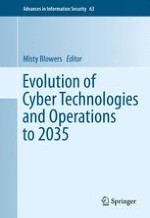
2015 | OriginalPaper | Buchkapitel
Cyberspace Resiliency: Springing Back with the Bamboo
verfasst von : William Bryant
Erschienen in: Evolution of Cyber Technologies and Operations to 2035
Aktivieren Sie unsere intelligente Suche, um passende Fachinhalte oder Patente zu finden.
Wählen Sie Textabschnitte aus um mit Künstlicher Intelligenz passenden Patente zu finden. powered by
Markieren Sie Textabschnitte, um KI-gestützt weitere passende Inhalte zu finden. powered by